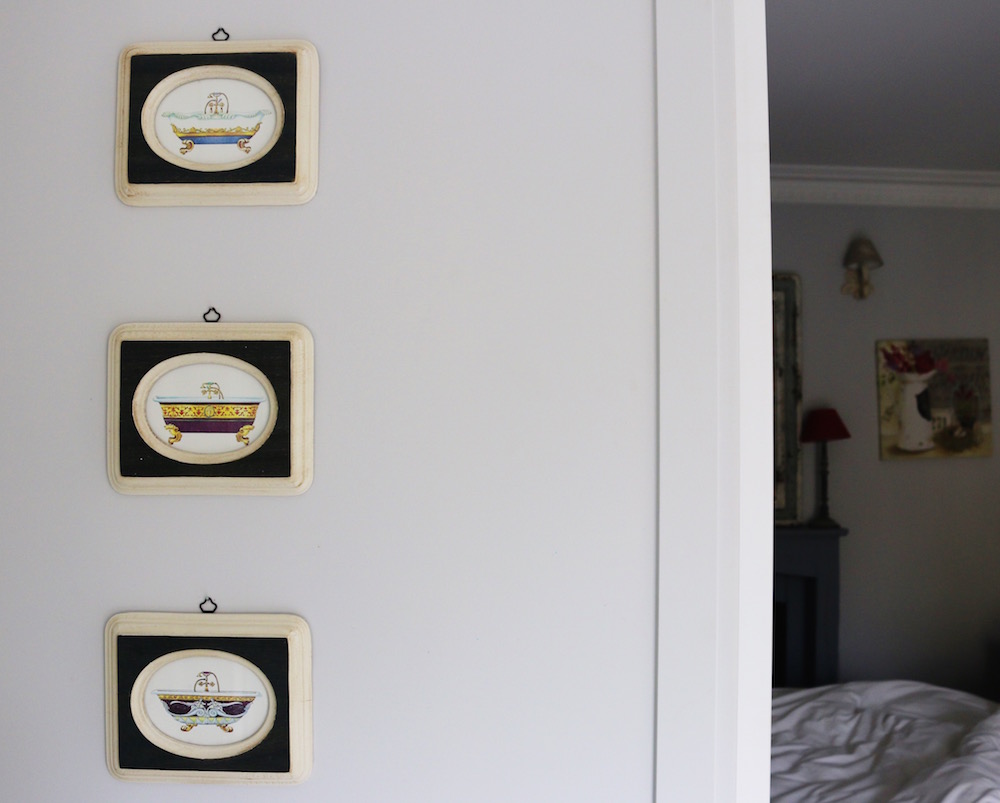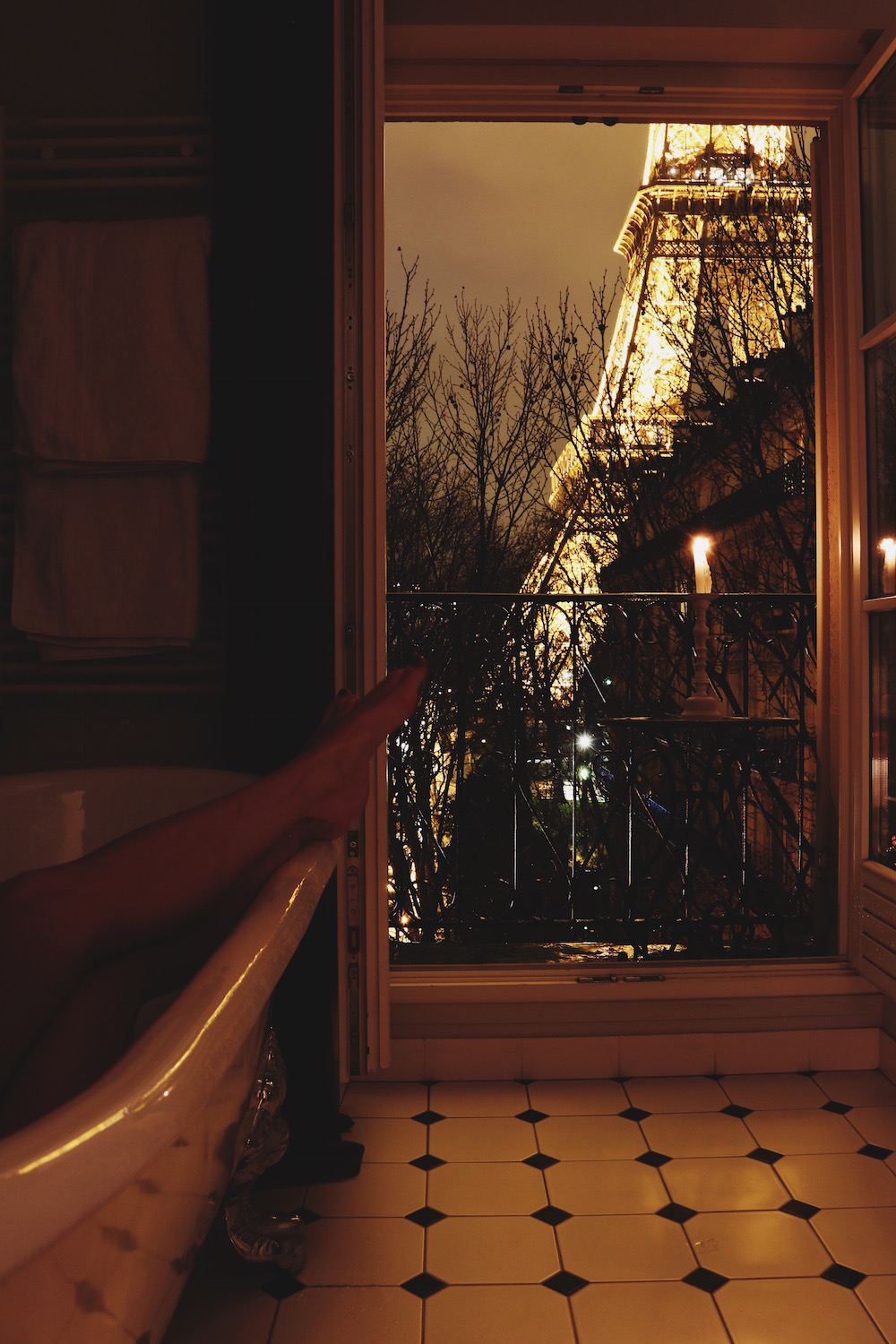This time she's just straight up showing off.
From Messy Nessy Chic:
Taking a Bath in Front of the Eiffel Tower
...If you’ve followed my adventures over the years in the city of light, you’ll know they haven’t included many trips up the Eiffel Tower (unless I’m time-travelling with Gustave Eiffel) and almost never involve feeling like a tourist; possibly one of my biggest phobias. Paris with Messy Nessy is a little less traditional, more off-the-beaten-path and avoids clichés like the French avoid soap– okay, okay, I promise that particular cliché really doesn’t have an ounce of truth to it, but it brought me so fittingly to this next part where I explain what lured me to the foot of the most visited tourist attraction in the world…

It was a bath tub. But not just any old tub....
...Behind the frosted sliding doors of a cozy bedroom inside a 5th floor Parisian apartment, draw the bath after dark and wait for the show to start…

Bath time will never be the same again....MUCH MOREAnd from Smithsonian Magazine:
The Man Who Sold the Eiffel Tower. Twice.
“Count” Victor Lustig was America’s greatest con man. But what was his true identity?
The air was as crisp as a hundred dollar bill, on April 27, 1936. A southwesterly breeze filled the bright white sails of the pleasure boats sailing across the San Francisco Bay. Through the cabin window of a ferryboat, a man studied the horizon. His tired eyes were hooded, his dark hair swept backwards, his hands and feet locked in iron chains. Behind a curtain of grey mist, he caught his first dreadful glimpse of Alcatraz Island.
“Count” Victor Lustig, 46 years old at the time, was America’s most dangerous con man. In a lengthy criminal career, his sleight-of-hand tricks and get-rich-quick schemes had rocked Jazz-Era America and the rest of the world. In Paris, he had sold the Eiffel Tower in an audacious confidence game—not once, but twice. Finally, in 1935, Lustig was captured after masterminding a counterfeit banknote operation so vast that it threatened to shake confidence in the American economy. A judge in New York sentenced him to 20 years on Alcatraz.
Lustig was unlike any other inmate to arrive on the Rock. He dressed like a matinee idol, possessed a hypnotic charm, spoke five languages fluently and evaded the law like a figure from fiction. In fact, the Milwaukee Journal described him as ‘a story book character’. One Secret Service agent wrote that Lustig was “as elusive as a puff of cigarette smoke and as charming as a young girl’s dream,” while the New York Times editorialized: “He was not the hand-kissing type of bogus Count—too keen for that. Instead of theatrical, he was always the reserved, dignified noble man.”
The fake title was just the tip of Lustig’s deceptions. He used 47 aliases and carried dozens of fake passports. He created a web of lies so thick that even today his true identity remains shrouded in mystery. On his Alcatraz paperwork, prison officials called him “Robert V. Miller,” which was just another of his pseudonyms. The con man had always claimed to hail from a long line of aristocrats who owned European castles, yet newly discovered documents reveal more humble beginnings.
In prison interviews, he told investigators that he was born in the Austria-Hungarian town of Hostinné on January 4, 1890. The village is arranged around a Baroque clock tower in the shadow of the Krkonoše mountains (it is now a part of the Czech Republic). During his crime spree, Lustig had boasted that his father, Ludwig, was the burgomaster, or mayor, of the town. But in recently uncovered prison papers, he describes his father and mother as the “poorest peasant people” who raised him in a grim house made from stone. Lustig claimed he stole to survive, but only from the greedy and dishonest.
More textured accounts of Lustig’s childhood can be found in various true crime magazines of the time, informed by his criminal associates and investigators. In the early 1900s, as a teenager, Lustig scampered up the criminal ladder, progressing from panhandler to pickpocket, to burglar, to street hustler. According to True Detective Mysteries magazine he perfected every card trick known: “palming, slipping cards from the deck, dealing from the bottom,” and by the time he reached adulthood, Lustig could make a deck of cards “do everything but talk.”
First-class passengers aboard transatlantic ships became his first victims. The newly rich were easy pickings. When Lustig arrived in the United States at the end of World War I, the “Roaring Twenties” were in full swing and money was changing hands at a fevered pace. Lustig quickly became known to detectives in 40 American cities as ‘the Scarred,’ thanks to a livid, two-and-a-half inch gash along his left cheekbone, a souvenir from a love rival in Paris. Yet Lustig was a considered a “smoothie” who had never held a gun, and enjoyed mounting butterflies. Records show that he was just five-foot-seven-inches tall and weighed 140 pounds.
His most successful scam was the “Rumanian money box.” It was a small box fashioned from cedar wood, with complicated rollers and brass dials. Lustig claimed the contraption could copy banknotes using “Radium.” The big show he gave to victims was sometimes aided by a sidekick named “Dapper” Dan Collins, described by the New York Times as a former ‘circus lion tamer and death-defying bicycle rider.’ Lustig’s repertoire also included fake horse race schemes, feigned seizures during business meetings, and bogus real estate investments. These capers made him a public enemy and a millionaire....MORE

A counterfeit $5 banknote that it is believed to be created by Lustig and Watts.
(Courtesy of Jeff Maysh)
HT: LongformI can see privately issued currency making a comeback should large denominations of the official stuff be scrapped, the demi-monde can usually be counted on to creatively fill a need.
And we've already got a resurgence of magic black-box deals populating Silicon (your choice on which syllable to emphasize) Valley, so, what was old is new again.